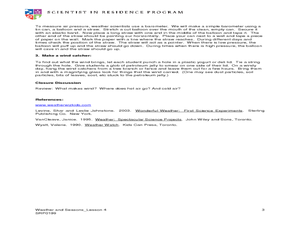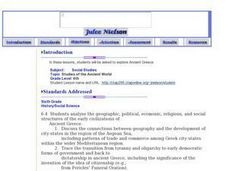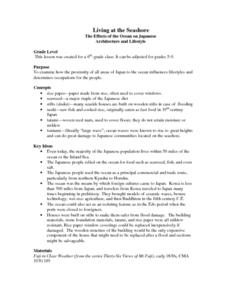Curated OER
Breaking News English: Indian Breaks Hot-Air Balloon Record
In this English worksheet, students read "Indian Breaks Hot-Air Balloon Record," and then respond to 47 fill in the blank, 7 short answer, 20 matching, and 8 true or false questions about the selection.
Curated OER
Wind and Air Pressure
Students make an anemometer, barometer, and wind catcher to see how wind and air pressure are related. For this wind lesson plan, students use these tools to measure the wind speed.
Curated OER
Food Web Mystery
Students describe typical marine food webs, and explain why food is generally scarce in the deep-ocean environment. They discuss reasons that seamounts may support a higher density of biological organisms than would appear to be possible.
Curated OER
Big Fleas Have Little Fleas!
Students study seamounts and learn the importance of structures to species. In this ocean explorer lesson, students participate in an activity that teaches them how to modify a seamount so that they are more suitable for species.
Curated OER
Cradles of Civilization Information Sheet
In this early civilizations worksheet, students read 4 paragraphs about great river civilizations and then label them Nile, Tigris and Euphrates, Indus, and the Huang He River Civilizations. Student also complete a writing prompt on the...
Curated OER
Floods
Students investigate how hurricanes impact a stream flow. In this floods lesson plan students predict the impact of storms on animals and interpret data.
Curated OER
Talking About Clouds
In this weather instructional activity, students read a selection about the water cycle and cloud identification. Then the students fill in the missing words in 5 sentences and write the name of 5 cloud types while describing the clouds.
Curated OER
Keep it Complex
Students consider the importance of biodiversity in the ocean layers. In this oceanography lesson, students use the Shannon-Weaver diversity index to analyze data. Students analyze the information collected and write a report offering...
Curated OER
Easy as Pi
Students examine structural features. In this life science lesson students complete an activity and quantify the impact of various modifications.
Curated OER
Feeding in the Flow
Students examine current flow and describe ways in which it may effect food of reef building corals. In this coral lesson students identify two environmental factors that may affect the morphology.
Curated OER
Starfish Project
Students discuss ocean waters, tides, tide pools and the animals which live in the tide pools. They practice the push and pull method with a chink of clay to create a starfish from clay. They apply texture and decorate the starfish...
Curated OER
Breaking Away (Or Not...)
Students compare and contrast common reproductive strategies used by benthic invertebrates. They describe the most common reproductive strategies among benthic invertebrates on a seamount, and explain why these strategi
Curated OER
Studies of the Ancient World
Sixth graders, after taking a pretest, write a paragraph describing the difference between Athens and Sparta and write an article about the ancient Phoenicians, describing their contributions to world history. They compare democracy in...
Curated OER
World War II in the Pacific and the End of the War
Students study the World War in the Pacific. In this Geography lesson, students develop an awareness of key issues and events from the conflict. Students write a well-organized essay describing this event.
Curated OER
Waves : An Alternative Energy Source
Students evaluate the feasibility of wave energy as an alternative source of energy. In this alternative energy source lesson students are introduced to renewable and nonrenewable energy and study energy production.
Curated OER
Ocean Tides
In this ocean tides worksheet, students read 2 pages about ocean tides and answer true or false questions about it. Students complete 10 questions.
Curated OER
Head to Foot
Students describe the body form and major anatomical structures of squids and describe some unusual or unique features of newly-discovered deep water squid species. They infer what types of food squids use from their anatomical features.
Curated OER
Climate, Corals, and Change
Young scholars examine oxygen isotope ratios and how they are related to water temperature. They also identify three forcing factor changes for climate change.
Curated OER
Hudson Canyon Expedition Let's Bet on Sediments!
Students investigate and analyze the patterns of sedimentation in the Hudson Canyon students observe how heavier particles sink faster than finer particles. They study that submarine landslides (trench slope failure) are
Curated OER
Leaving Home
Students explain the importance of larval dispersal and retention to populations. They collect data on organisms and examine it.
Curated OER
Living at the Seashore
Students examine how the proximity of all areas of Japan to the ocean influences lifestyles and determines occupations for the people. This lesson includes lesson extensions and a concept list.
Curated OER
A Common Thread
Sixth graders explore the Renaissance. In this Renaissance lesson plan, 6th graders study the culture and society of the middle ages. Students research the geography and climate of the times and discover how these affected agriculture.























